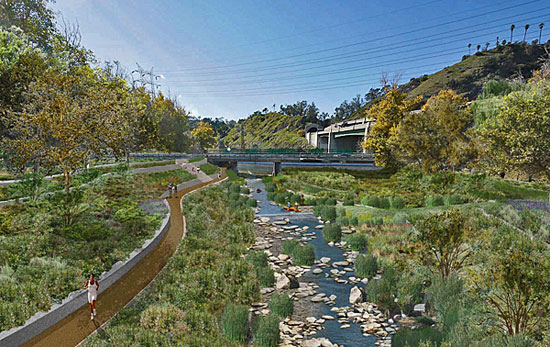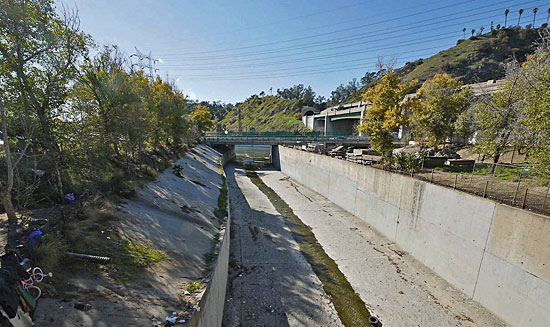Support floods the L.A. River
October 31, 2013

A greener Los Angeles River, as depicted in this rendering, is on the way under federal financing plans.
The Los Angeles River is getting a lot of love these days. The infamous concrete channel that’s been likened to a scar on Los Angeles’ civic psyche is now on the front burner to receive major improvements, and it’s got a lot of political muscle in its corner.
On Tuesday, as Mayor Eric Garcetti led a contingent of city officials and activists to rally support in Washington D.C. for a massive project to restore the river’s natural habitat and create more open space for the public, the L.A. County Board of Supervisors waded into the effort from a continent away.
Acting on a motion by Supervisor Gloria Molina, the Board voted 3-0 to back Alternative 20 of the Los Angeles River Ecosystem Restoration Feasibility Study, and to send a letter of support to federal agencies, President Barack Obama and the Los Angeles Congressional delegation. Supervisors Michael D. Antonovich and Don Knabe abstained from the vote. Alternative 20 is the most sweeping of four alternatives reviewed in the study—which was commissioned by the United States Army Corps of Engineers—and it comes with a $1 billion price tag that would be shared by the City of L.A. and the federal government.
Lewis MacAdams, president of Friends of the Los Angeles River, a non-profit group dedicated to restoring the waterway, said the Supervisors’ move adds much-needed momentum to the cause.
“It makes it clear on every level that the people of Los Angeles want to see the restoration of the river to the largest possible scale,” MacAdams said. “What you’re seeing from the Board of Supervisors is a commitment to the restoration of the river from the area’s most powerful political body.”
When the Corps released its study on plans to restore 11 miles of the river between Griffith Park and downtown L.A. last month, the long-awaited report met with a lukewarm reception. Of the four alternatives analyzed, the Corps tentatively recommended Alternative 13, the second-least-extensive option. It would restore 588 acres of habitat and create four miles of new trails, three new restrooms and five wildlife viewing areas. But MacAdams said that, while those improvements are welcomed, the $453-million plan still wouldn’t do L.A.’s waterway justice.
“The Corps wants to get out on the cheap, so they aren’t even paying attention to their own study,” MacAdams said. “Alternative 13 only restores minimal habitat.”
But MacAdams is optimistic about getting something better. He said the growing list of supporters for a larger project now includes U.S. Senators Barbara Boxer and Dianne Feinstein, along with local members of the House of Representatives and Minority Leader Nancy Pelosi. But while Mayor Garcetti and other supporters are pushing for Alternative 20, the project faces an uphill battle in Congress, where budgetary constraints and partisan gridlock are the order of the day. On Tuesday, Feinstein acknowledged that it may be necessary to find a middle ground. (Another option in the feasibility study, Alternative 16, splits the difference between the two plans—including some, but not all, of the improvements for a price tag of $840 million.)
“Even if we don’t get what we want and have to settle for [Alternative] 13 or 16, it begins to take back the river, and that’s a journey that’s going to take a long time,” MacAdams said.
The L.A. River was encased in concrete after repeated flooding devastated parts of the city in the early part of the 20th century. The massive project stopped the flooding, but also destroyed miles of habitat and transformed the river into an eyesore, driving local residents from its banks and making it the butt of jokes on a national level.
In recent years, interest in revitalizing the river has surged. In 2010, the Environmental Protection Agency declared it a “navigable waterway,” paving the way for enforcement of the Clean Water Act within its 834-square-mile watershed. And just this past summer, a kayaking pilot program experimented with literally navigating the river.
All three options under consideration would return 13 currently-underground streams to the surface, create new habitat and restore, at least partially, three adjacent properties—Taylor Yard, Piggyback Yard and Pollywog Parcel. Alternatives 16 and 20 also would add terracing along stretches of the riverbank, remove some of the concrete and create new wetlands. However, only Alternative 20 would connect the river to L.A. State Historic Park, bring large-scale restoration to the river’s confluence with the Verdugo Wash and widen part of the river bed.
For the county, Alternative 20 would be a big help in managing the watershed, said Mark Pestrella, an assistant director for the Department of Public Works. While the Army Corps is tasked with taking care of the stretch of river where the project would occur, the county Flood Control District manages other sections of the waterway. Bringing more people to the river would induce them to help take care of it and support its continued improvement, Pestrella said. The restoration project would join an ongoing evolution of the urban river that stretches back to the 1980s and includes the 1992 Los Angeles River Master Plan, the first study to take a comprehensive look at the entire length of the river to look for opportunities for recreation, restoration of habitat and creation of open space.
“We are midstream—the County sees this as the next step,” Pestrella said. “We’ve done hundreds of millions of dollars in L.A. River Master Plan improvements already.”
Because Alternative 20 adds new park space and improves connections to neighboring communities, county officials and other supporters say it would draw more people seeking recreation opportunities.
“Until people actually reach out and touch the environment and nature, they don’t know what they don’t have,” Pestrella said. “Once people make an investment in it that improves their life, they just want more of it. We’re funded by the public so we need that buying in—we need people to turn toward the river.”
Posted 10/31/13













 405 bridge work causes a stink
405 bridge work causes a stink
